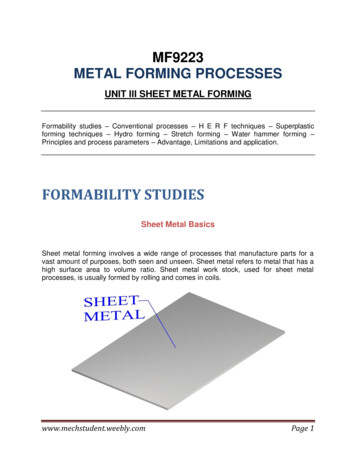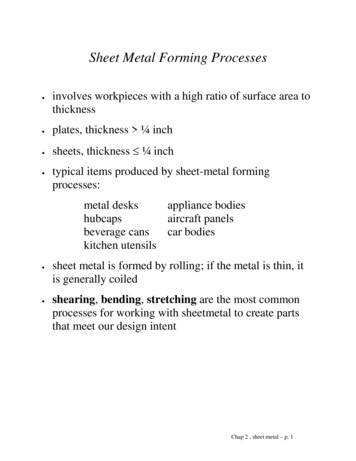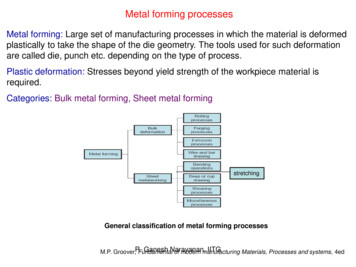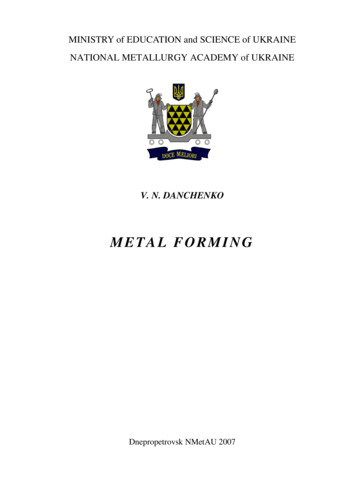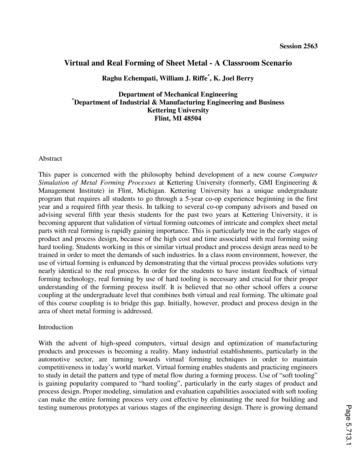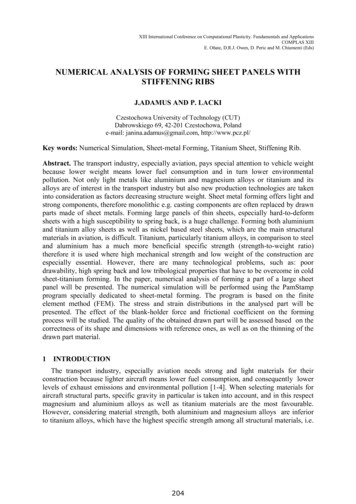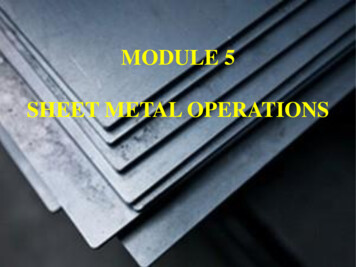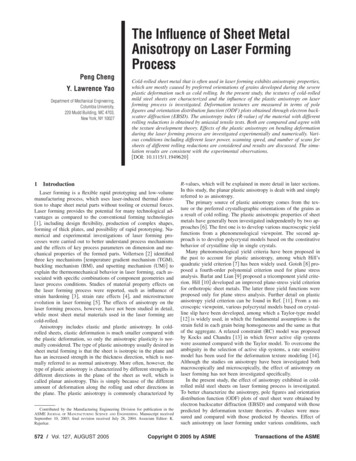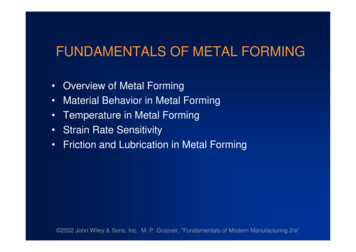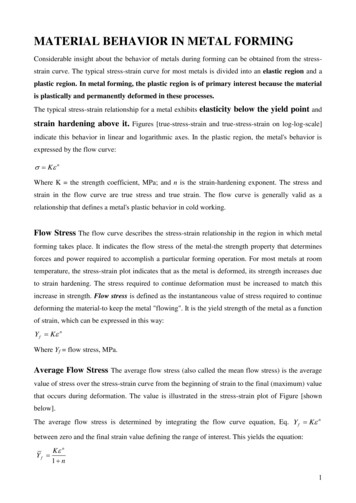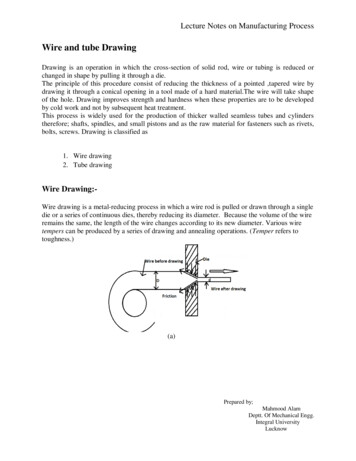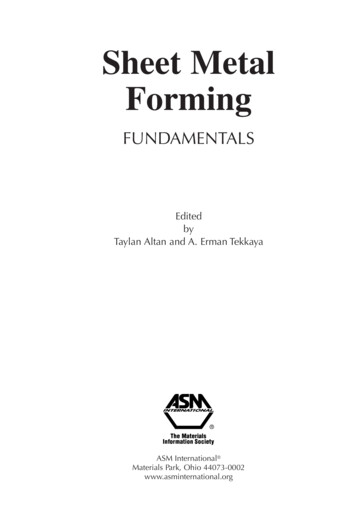
Transcription
Sheet MetalFormingFUNDAMENTALSEditedbyTaylan Altan and A. Erman TekkayaASM International Materials Park, Ohio 44073-0002www.asminternational.org
Copyright 2012byASM International All rights reservedNo part of this book may be reproduced, stored in a retrieval system, or transmitted, in any form or by anymeans, electronic, mechanical, photocopying, recording, or otherwise, without the written permission of thecopyright owner.First printing, August 2012Great care is taken in the compilation and production of this book, but it should be made clear that NOWARRANTIES, EXPRESS OR IMPLIED, INCLUDING, WITHOUT LIMITATION, WARRANTIES OFMERCHANTABILITY OR FITNESS FOR A PARTICULAR PURPOSE, ARE GIVEN IN CONNECTIONWITH THIS PUBLICATION. Although this information is believed to be accurate by ASM, ASM cannot guarantee that favorable results will be obtained from the use of this publication alone. This publication is intendedfor use by persons having technical skill, at their sole discretion and risk. Since the conditions of product ormaterial use are outside of ASM’s control, ASM assumes no liability or obligation in connection with any useof this information. No claim of any kind, whether as to products or information in this publication, and whetheror not based on negligence, shall be greater in amount than the purchase price of this product or publication inrespect of which damages are claimed. THE REMEDY HEREBY PROVIDED SHALL BE THE EXCLUSIVEAND SOLE REMEDY OF BUYER, AND IN NO EVENT SHALL EITHER PARTY BE LIABLE FORSPECIAL, INDIRECT OR CONSEQUENTIAL DAMAGES WHETHER OR NOT CAUSED BY ORRESULTING FROM THE NEGLIGENCE OF SUCH PARTY. As with any material, evaluation of the materialunder end-use conditions prior to specification is essential. Therefore, specific testing under actual conditions isrecommended.Nothing contained in this book shall be construed as a grant of any right of manufacture, sale, use, or reproduction, in connection with any method, process, apparatus, product, composition, or system, whether or not covered by letters patent, copyright, or trademark, and nothing contained in this book shall be construed as a defense against any alleged infringement of letters patent, copyright, or trademark, or as a defense against liabilityfor such infringement.Comments, criticisms, and suggestions are invited, and should be forwarded to ASM International.Prepared under the direction of the ASM International Technical Book Committee (2011–2012), Bradley J.Diak, Chair.ASM International staff who worked on this project include Scott Henry, Senior Manager, Content Developmentand Publishing; Karen Marken, Senior Managing Editor; Steven L. Lampman, Content Developer; Sue Sellers,Editorial Assistant; Bonnie Sanders, Manager of Production; Madrid Tramble, Senior Production Coordinator;and Diane Whitelaw, Production Coordinator.Library of Congress Control Number: 2011945709ISBN-13: 978-1-61503-842-8ISBN-10: 0-61503-842-6SAN: 204-7586ASM International Materials Park, OH 44073-0002www.asminternational.orgPrinted in the United States of America
Sheet Metal Forming—Fundamentals T. Altan and A.E. Tekkaya, editors Copyright 2012 ASM International All rights reservedwww.asminternational.orgContentsPreface. viiAbbreviations and Symbols. ixChapter 1Metal Forming Processes in Manufacturing. 11.1 Classification of Manufacturing Processes 11.2 Characteristics of Manufacturing Processes 11.3 Metal Forming Processes in Manufacturing 21.4 Classification of Metal Forming Processes 3Chapter 2Classification and Description of Sheet Metal Forming Operations. 52.1 Process Variables 52.2 Sheet Metal Forming as a System 62.3 Classification of Geometries 102.4 Bending and Flanging 112.5 Blank Preparation 142.6 Deep Drawing 152.7 Stretch Forming 182.8 Incremental Forming 222.9 Hybrid Forming Processes 23Chapter 3Plastic Deformation—Strain and Strain Rate. 273.1 Homogeneous or Uniform Deformation 273.2 Volume Constancy during Plastic Deformation 293.3 Infinitesimal True Strains and Strain Rates 293.4 Principal Strains and Strain Paths 313.5 Equivalent Strain Rate and Equivalent Strain 32Chapter 4Plastic Deformation—Flow Stress, Anisotropy, and Formability. 334.1 Tensile Test 334.2 Flow Stress Curves. 374.3 Methods to Determine Flow Stress of Sheet Materials 394.4 Formability 444.5 Forming Limit Curves (FLCs) 48iii
iv / ContentsChapter 5 Plastic Deformation—State of Stress, Yield Criteria Flow Rule, andHardening Rules. 535.1 General State of Stress 535.2 Principal Stresses 545.3 Volumetric Stress or Hydrostatic Pressure 545.4 Deviatoric Stress 555.5 Isotropic Yield Criteria (Flow Criteria) 565.6 Tresca Yield Criterion 565.7 Von Mises Yield Criterion 575.8 Comparison of Tresca and von Mises Criteria 585.9 Anisotropic Yield Criteria 585.10 Flow Rules 635.11 Power and Energy of Deformation 645.12 Effective Strain and Effective Strain Rate 655.13 Hardening Laws 66Chapter 6Materials for Sheet Forming. 736.1 Low-Carbon Sheet Steels 736.2 Coated Sheet Steels 786.3 Stainless Steels 796.4 Aluminum Alloys 826.5 Magnesium Alloys 86Chapter 7Friction and Lubrication. 897.1 Lubrication Mechanisms and Friction Laws 897.2 Lubricants for Sheet Metal Forming 917.3 Tribological Tests for Evaluation of Lubricants in SheetMetal Forming 947.4 Tribological Tests for Warm and Hot Stamping 987.5 Tribological Tests for Punching and Blanking 100Chapter 8Deep Drawing of Round and Rectangular Cups. 1058.1 Deformation during Deep Drawing 1058.2 Deep Drawing of Rectangular Cups 1218.3 Prediction of Punch Force and BHF—Case Study 123Chapter 9Principles of Sheet Forming Presses. 1299.1 Components of Presses 1299.2 Characteristics of Presses 1319.3 Quick Die Change Systems 139Chapter 10 Mechanical Presses. 14510.1 Mechanical Press Designs 14510.2 Characteristics of Mechanical Presses 15010.3 Other Features of Mechanical Presses 155Chapter 11 Electromechanical Servo-Drive Presses. 16111.1 Servo-Press Drives Versus Conventional Press Drives 16111.2 Servo-Press Drives 163
Contents / v11.3 Applications 16711.4 Cushions/Die Cushions 17311.5 Comparison of Mechanical and Servo Presses 17411.6 New Process Development Using Servo-Press Characteristics 17611.7 Summary 178Chapter 12 Hydraulic Presses. 18112.1 Components of Hydraulic Presses 18212.2 Drive Systems 18812.3 Characteristics of Hydraulic Presses 19012.4 Hydraulic Press Designs 196Chapter 13 Cushion Systems for Sheet Metal Forming. 20313.1 Blank holder Systems in Double-Action Presses 20313.2 Single-Action Presses with Cushion System 20613.3 Multipoint Cushion (MPC) Systems 211Appendix A Flow Stress Curves. 221Appendix B Glossary. 233Index. 267
Edited by Taylan Altan and A. Erman Tekkaya ASM International Materials Park, Ohio 44073-0002 www.asminternatio
